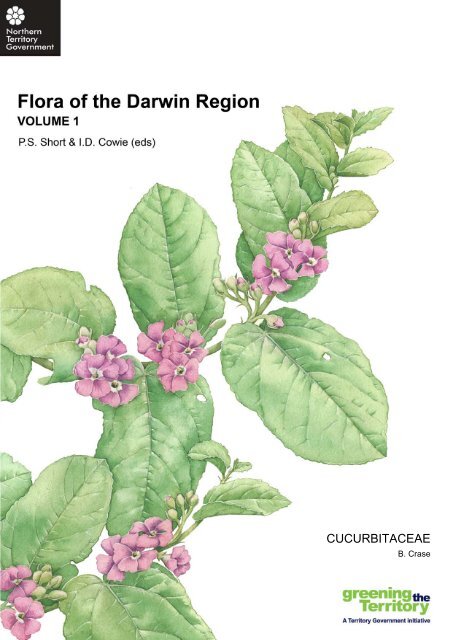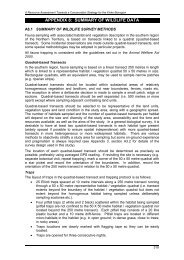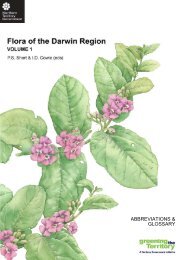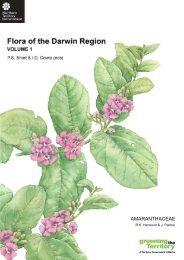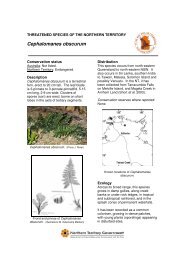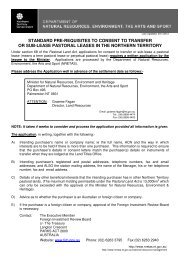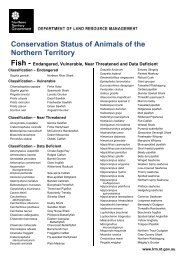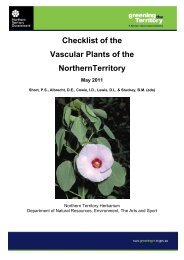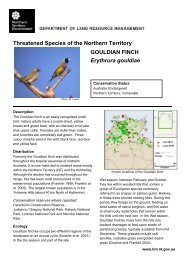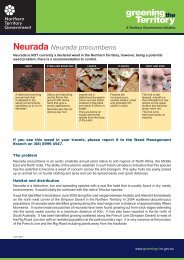CUCURBITACEAE - Department of Land Resource Management
CUCURBITACEAE - Department of Land Resource Management
CUCURBITACEAE - Department of Land Resource Management
You also want an ePaper? Increase the reach of your titles
YUMPU automatically turns print PDFs into web optimized ePapers that Google loves.
<strong>CUCURBITACEAE</strong><br />
B. Crase
National Library <strong>of</strong> Australia<br />
Cataloguing-in-publication entry (PDF):<br />
Flora <strong>of</strong> the Darwin Region Volume 1<br />
ISBN: 9781921519949 (PDF)<br />
Series: Northern Territory Botanical Bulletin No. 37<br />
Notes: Includes bibliographical references and<br />
index.<br />
Subjects: Botany – Northern Territory – Darwin<br />
region – Plants – Identification<br />
Other Authors/Contributors: Short, P.S.,<br />
Cowie, I.D., Northern Territory <strong>Department</strong><br />
<strong>of</strong> Natural <strong>Resource</strong>s, Environment, the Arts<br />
and Sport.<br />
Dewey Number: 581.994295<br />
ISSN: 0314-1810<br />
Date <strong>of</strong> Publication: March 2011<br />
Cover: Helicteres procumbens (Benth.) Cowie, ined.<br />
Cover Artist: R. Walter<br />
Editors: P.S. Short and I.D. Cowie<br />
Illustrations: M. Osterkamp<br />
Typesetting: D. Bisa and M. Voukalis<br />
Photographic Editor: B.M. Stuckey<br />
Authors contributing to this publication:<br />
D.E. Albrecht<br />
Northern Territory Herbarium, <strong>Department</strong> <strong>of</strong><br />
Natural <strong>Resource</strong>s, Environment, the Arts and<br />
Sport, P.O. Box 1120, Alice Springs, N.T. 0871,<br />
Australia<br />
R.M. Barker<br />
State Herbarium <strong>of</strong> South Australia, Plant<br />
Biodiversity Centre, P.O. Box 2732, Kent Town,<br />
S.A. 5071, Australia<br />
I.D. Cowie; B. Crase * ; D.J. Dixon *; C.R. Dunlop *;<br />
R.K. Harwood *; R.A. Kerrigan *; G.J. Leach *;<br />
C. Mangion *; P.S. Short; G.M. Wightman *<br />
Northern Territory Herbarium, <strong>Department</strong> <strong>of</strong><br />
Natural <strong>Resource</strong>s, Environment the Arts and<br />
This book is copyright. Apart from any fair dealing<br />
for the purpose <strong>of</strong> private study, research, criticism<br />
or review, as permitted under the Copyright Act, no<br />
part <strong>of</strong> this publication may be produced by any<br />
process whatsoever without the written permission<br />
<strong>of</strong> the publisher.<br />
© Northern Territory Government<br />
Publisher:<br />
Northern Territory Herbarium<br />
<strong>Department</strong> <strong>of</strong> Natural <strong>Resource</strong>s,<br />
Environment, the Arts and Sport<br />
P.O. Box 496<br />
Palmerston, N.T. 0831, Australia<br />
Sport, P.O. Box 496, Palmerston, N.T. 0831,<br />
Australia<br />
L.A. Craven<br />
Australian National Herbarium, Centre for<br />
Plant, Biodiversity Research, G.P.O. Box 1600,<br />
Canberra, A.C.T. 2601, Australia<br />
L.L. Forman† (deceased)<br />
Royal Botanic Gardens, Kew, Richmond,<br />
Surrey, TW9 3AB, UK<br />
B. Jackes<br />
James Cook University Herbarium, School <strong>of</strong><br />
Marine and Tropical Biology, James Cook<br />
University, Townsville, Qld 4811, Australia<br />
L. Jessup<br />
Queensland Herbarium Mt Coot-tha Road,<br />
Toowong, Qld 4066, Australia<br />
J. Palmer<br />
Australian National Herbarium, G.P.O. Box<br />
1600, Canberra, A.C.T. 2601, Australia<br />
*Former employee NT Herbarium<br />
Suggested citation for this article:<br />
Crase, B. (2011). Curcurbitaceae. In Short, P.S.<br />
& Cowie, I.D. (eds), Flora <strong>of</strong> the Darwin Region.<br />
(Northern Territory Herbarium, <strong>Department</strong> <strong>of</strong><br />
Natural <strong>Resource</strong>s, Environment, the Arts and<br />
Sport). Vol. 1, pp. 1–17.<br />
http://www.nt.gov.au/nreta/wildlife/plants_<br />
herbarium/index.html
<strong>CUCURBITACEAE</strong><br />
B. Crase<br />
Herbaceous, mostly climbing or trailing plants, usually with tendrils; tendrils at nodes, simple or<br />
branched. Leaves alternate, palmately or sometimes pinnately veined and <strong>of</strong>ten lobed or sometimes<br />
palmately compound, extrafloral nectaries <strong>of</strong>ten present; stipules absent. Flowers mostly unisexual<br />
(plants monoecious or dioecious), usually actinomorphic, mostly in axillary inflorescences or solitary in<br />
axils. Calyx mostly 5-lobed. Corolla 5-lobed or <strong>of</strong> 5 free petals, the corolla <strong>of</strong> male flowers sometimes<br />
unlike that <strong>of</strong> female flowers. Stamens basically 5 and alternate with corolla lobes but <strong>of</strong>ten reduced to 3,<br />
2 having tetrasporangiate dithecal anthers, 1 having a bisporangiate monothecal anther, stamens free or<br />
variously united; staminodes may be present in female flowers. Gynoecium <strong>of</strong> (2) 3 (5) carpels united to<br />
form an inferior or half-inferior compound ovary; ovules 1–many, anatropous; style commonly solitary,<br />
stigmas 1–5, entire or lobed. Fruit a pepo, berry, gourd or capsule, indehiscent or dehiscing via an<br />
operculum, valves or by splitting irregularly, occasionally explosively dehiscent. Seeds 1-many, large and<br />
commonly compressed, sometimes winged, surfaces smooth or variously ornamented; embryo large;<br />
endosperm absent or nearly so.<br />
A family <strong>of</strong> about 120 genera and over 900 species, widely distributed in tropical and subtropical<br />
regions <strong>of</strong> Africa, Asia, Australia and America. Represented in Australia by 19 genera and c. 45 species,<br />
with about 13 <strong>of</strong> these naturalised. In the N.T. there are ten genera and 20 species, with six genera and<br />
perhaps eight species in the D.R. This account is <strong>of</strong> the Top End species.<br />
The family contains some <strong>of</strong> the earliest cultivated plants in both the Old and New World tropics and<br />
subtropics. Examples <strong>of</strong> species grown as food crops include the Cucumber (Cucumis sativus), Rock and<br />
Honeydew melons (Cucumis melo var. melo), Water Melon (Citrullus lanatus), West Indian Gherkin<br />
(Cucumis anguria), Pumpkins and Squashes (Cucurbita moschata and C. mixta), Snake Gourd (Trichosanthes<br />
cucumerina var. anguina), Bitter Gourd (Momordica charantia) and Pepitos (Cucurbita pepo). Other uses<br />
include medicinal applications, e.g. as an abortifacient, as a treatment for diabetes, and for earache.<br />
Gourds are used as containers and as resonators in musical instruments such as the sitar.<br />
The term “flower-scape” is used in descriptions <strong>of</strong> taxa with single flowers to describe the combination<br />
<strong>of</strong> the peduncle and the pedicel, a single bract marking where the two join.<br />
Taxonomic references: Jeffrey (1967, 1980); Cronquist (1981); Telford (1982); Vaughan & Geissler<br />
(1997); Matthew (1999); Andres (2004); Matthews & Endress (2004).<br />
1 Tendrils simple .............................................................................................................. 2<br />
1: Tendrils branched ......................................................................................................... 5<br />
2 Leaves with 2–9 depressed glands, each to 1 mm diam., at the base<br />
<strong>of</strong> the lamina .................................................................................................................. Coccinia<br />
2: Leaves lacking depressed glands at the base <strong>of</strong> the lamina .................................... 3<br />
3 Male flowers subtended by a single, green, suborbicular bract to<br />
c. 10 mm long ................................................................................................................. Momordica<br />
3: Male flowers subtended by a tiny bract, or bract absent ........................................ 4<br />
4 Fruit smooth or s<strong>of</strong>tly hairy; corolla yellow .............................................................. Cucumis<br />
4: Fruit s<strong>of</strong>tly spiny; corolla white .................................................................................. Muelleragia<br />
5 Corolla margin fimbriate, fimbriae to 15 mm long; leaf lamina with<br />
a dense cover <strong>of</strong> minute hairs and also with scattered, larger hairs ..................... Trichosanthes<br />
5: Corolla margin entire; leaf lamina with the undersurface or both surfaces<br />
sometimes or commonly with hairs surrounded by multicellular rings ............... 6<br />
FDRV1 March 2011
2<br />
<strong>CUCURBITACEAE</strong><br />
6 Fruit with a fleshy endocarp, globose to ellipsoidal, 15–25 mm diam., red<br />
with white stripes when ripe; bracts absent; corolla deeply 5-lobed, lobes<br />
4–9 mm long; undersurface <strong>of</strong> leaf lamina with hairs and short prickles ............ Diplocyclos<br />
6: Fruit with a fibrous, spongy endocarp, cylindrical to ellipsoidal or<br />
ovoid, 25–115 mm long, 20–45 mm diam., ripening to brown; glandular<br />
bracts to 4 mm long; petals free, 15–40 mm long; both surfaces <strong>of</strong> leaf<br />
lamina with hairs, short prickles absent .................................................................... Luffa<br />
COCCINIA Wight & Arn.<br />
Dioecious or (not Australia) monoecious climbing or trailing annual or perennial herbs. Tendrils simple<br />
or 2-branched. Leaves simple, variable in shape, entire to palmately 3–5-lobed. Male flowers solitary, in<br />
fascicles or (not Australia) in racemes; calyx 5-lobed; corolla 5-lobed, ovate, white or yellow; stamens 3,<br />
inserted at the base <strong>of</strong> the broadly campanulate floral tube; anthers fused into a column or connate<br />
apically, 2 bilocular, 1 unilocular; thecae triplicate; disc absent. Female flowers solitary, perianth similar<br />
to male flowers; ovary globose to ellipsoidal, glabrous; ovules many, horizontal; staminodes 3; stigma<br />
3-lobed. Fruit globose to elongate-cylindrical, fleshy, indehiscent, with a thin pericarp, red or red<br />
mottled with green. Seeds many, ovate, compressed.<br />
Genus <strong>of</strong> c. 30 species, mostly native to tropical Africa with one species found throughout Asia, Malesia<br />
and Australia.<br />
Taxonomic references: Jeffrey (1967); Telford (1982); Matthew (1999).<br />
*C. grandis (L.) Voigt<br />
Annual or perennial, trailing or climbing vine<br />
with simple tendrils; stems to 2 m long, angled,<br />
glabrous. Leaves on glabrous petioles (7) 20–<br />
35 (45) mm long; lamina ovate to orbicular, (37) 50–<br />
100 (115) mm long, (35) 60–80 (110) mm wide,<br />
shallowly to deeply palmately 3–5-lobed, basally<br />
cordate, with 2–9 glands near the attachment <strong>of</strong><br />
the petiole and near junctions <strong>of</strong> secondary veins<br />
on the lower surface, margins entire or dentate<br />
and with a spine on each tooth, both surfaces<br />
distinctly punctate, with scattered papillae and<br />
the prominent veins <strong>of</strong> the lower surface with<br />
scattered hairs. Male flowers solitary; pedicels 27–<br />
45 mm; calyx lobes subulate, recurved, 1–4 mm<br />
long, glabrous; corolla 12–42 mm long, white,<br />
both surfaces with scattered hairs; stamens 3,<br />
c. 5 mm long; anthers connate, flexuous, 2 bilocular,<br />
1 unilocular. Female flowers with pedicels 4–40 mm<br />
long; perianth similar to male flowers; ovary<br />
ovoid, elongate, 10–15 mm long, glabrous; style<br />
c. 8 mm long; stigmas 3, fimbriate, c. 8 mm long.<br />
Fruit ovoid to ellipsoidal, 40–70 mm long, 25–<br />
45 mm diam., red, glabrous; pedicel (10) 23–<br />
38 mm long. Seeds pyriform in outline, c. 8 mm<br />
long, 4–5 mm wide, 1.5–2 mm thick, compressed,<br />
surface granular. Flowering & fruiting: Feb.–Oct.<br />
Fig. 1 (Russell-Smith 5020): Pl. 1 (unvouchered).<br />
Reported to be native to tropical Africa, Asia and<br />
Malesia, and a weed in Fiji, Hawaii, the West<br />
Indies, tropical North and South America, and<br />
Australia (W.A, N.T., Qld) where it was<br />
presumably introduced because <strong>of</strong> its culinary<br />
uses. However, populations in eastern Arnhem<br />
<strong>Land</strong> give every appearance <strong>of</strong> being native. In<br />
the N.T. it grows in riparian vine forest, monsoon<br />
forest and coastal vine thicket on sandy soil or<br />
in coastal areas on dunes near beaches or<br />
mangroves. Localities in the D.R. include the<br />
Nightcliff foreshore and the Shoal Bay Recycling<br />
Centre at Berrimah.<br />
Fruit are used to make pickles and as a vegetable;<br />
new shoots are also cooked and eaten. A root<br />
extract is used to treat diabetes and a leaf extract<br />
to treat earaches.<br />
FDRV1 March 2011
Fig. 1<br />
<strong>CUCURBITACEAE</strong><br />
FDRV1 March 2011<br />
3
4<br />
<strong>CUCURBITACEAE</strong><br />
CUCUMIS L.<br />
Monoecious or rarely dioecious, annual or perennial trailing herbs; stems hispid or scabrid-hairy. Tendrils<br />
simple. Leaves simple, entire to palmately 3–7-lobed. Male flowers solitary or in fascicles, racemes or<br />
pedunculate groups; calyx 5-lobed; corolla 5-lobed, yellow; stamens 3, inserted in about the middle <strong>of</strong><br />
the campanulate hypanthium; filaments and anthers free; anthers 2 bilocular, 1 unilocular, locules straight,<br />
slightly curved or flexuose; with or without an apical connective; disc gland-like or subglobose, free<br />
from the tube. Female flowers solitary or in fascicles; perianth similar to male flowers; ovary globose to<br />
ellipsoidal, pubescent; ovules few to many, horizontal; staminodes 3 or absent; style inserted in annular<br />
disc or disc absent; stigma 3-lobed. Fruit solitary or in axillary clusters, globose, ellipsoidal or ellipsoidaloblong,<br />
fleshy, indehiscent or rarely expelling seeds explosively, smooth and glabrous or pubescent,<br />
with (not D.R.) scattered to dense fleshy spines, pustules or tubercles; red, yellow, greenish or brownish<br />
when ripe. Seeds few to many, elliptic, ovate or obovate, turgid or compressed, smooth, pitted, granular<br />
or with thickened raised margins.<br />
Genus <strong>of</strong> more than 50 species, mostly in the Old World tropics and with about 11 species, at least five<br />
<strong>of</strong> them naturalised, in Australia. Four species occur in the N.T.; three <strong>of</strong> them are in the Top End and<br />
are described here, while the introduced C. myriocarpus is common in southern N.T.<br />
Several species are widely cultivated and naturalised in tropical regions e.g. C. satvius (Cucumber), C. melo<br />
(Cantaloupe, Honeydew Melon), C. metuliferus (Horned Cucumber) and C. anguria (West Indian Gherkin).<br />
Formerly more narrowly defined (Jeffrey 1967) but molecular studies indicated that to be monophyletic<br />
five further genera – including Mukia – needed to be placed in a more broadly defined Cucumis<br />
(Ghebretinsae et al. 2007a, b; Schaefer 2007).<br />
Taxonomic references: Jeffrey (1967, 1980); Telford (1982); Kirkbride (1993); Matthew (1999);<br />
Ghebretinsae et al. (2007a, b); Renner et al. (2007); Schaefer (2007).<br />
1 Stamens with connective appendages at apex; corolla lobes 6–12 mm long;<br />
seeds smooth; fruit ellipsoidal, 10–40 mm ............................................................... C. melo subsp. agrestis<br />
1: Stamens without connective appendages at apex; corolla lobes 1.5–6 mm;<br />
seeds granular or pitted; fruit subglobose, 4–12 mm diam..................................... 2<br />
2 Fruit 5–12 mm diam.; leaf lamina commonly longer than wide; 3–8 seeds<br />
per fruit............................................................................................................................ C. maderaspatanus<br />
2: Fruit 4–5 mm diam.; leaf lamina frequently wider than long; seeds<br />
frequently 2 per fruit, rarely 1 or 3 ............................................................................ C. sp. Gunlom<br />
C. maderaspatanus L.<br />
Mukia maderaspatana (L.) M. Roem.<br />
Perennial trailing or climbing vine; stems to 3 m<br />
long and with hooked hairs, with a woody<br />
rootstock. Tendrils simple. Leaves simple; nearsessile<br />
or with petioles to 45 (84) mm long and<br />
with a sparse to dense cover <strong>of</strong> hooked hairs;<br />
lamina triangular to widely deltate, hastate, (26)<br />
30–45 (80) mm long, (18) 25–50 (61) mm wide,<br />
rarely palmately 3-lobed; margins dentate to<br />
lobulate, with very dense hooked hairs; base<br />
cordate; apex obtuse to acuminate; surfaces with a<br />
sparse to dense cover <strong>of</strong> tubercle-based hairs,<br />
hairs smaller on the lower surface, densely hairy at<br />
base <strong>of</strong> leaf blade, the prominent veins with a<br />
dense cover <strong>of</strong> larger curved hairs <strong>of</strong> two sizes.<br />
Male flowers in 2–15-flowered fascicles or short<br />
racemes; peduncle to 6 mm long; pedicel 1–6 mm<br />
long; hypanthium narrowly campanulate, 4–5 mm<br />
long; calyx lobes triangular to subulate, 1 mm<br />
long; corolla lobes ovate, 1.5–4 mm long, yellow,<br />
outer surface sparsely hairy, inner surface<br />
papillate; anthers with straight locules. Female<br />
flowers in 2–20-flowered fascicles, rarely solitary or<br />
co-axillary with males, sessile or on pedicels to<br />
4 mm long; perianth similar to male flowers; ovary<br />
globose, 1.5–2 mm diam., sparsely to densely hairy;<br />
ovules few; style 2–2.5 mm inserted in annular<br />
disc 0.8–1 mm diam. Fruit subglobose, 7–12 mm<br />
diam., scattered hairs to 2 mm long, green with<br />
paler stripes ripening to red. Seeds 3–8, ovate, 4–<br />
5.5 mm long, 2–3.5 mm wide, 1–2 mm high,<br />
turgid, surface granular, pale cream or black.<br />
Flowering & fruiting: all year.<br />
Fig. 2 (Chippendale, A7942; Michell 641; Russell-<br />
Smith 1961; Waterhouse 3186); Pl. 2 (unvouchered).<br />
FDRV1 March 2011
Tropical and subtropical Africa, Asia, Malesia, the<br />
Philippines and Australia (W.A., N.T., S.A., Qld).<br />
Widespread throughout the N.T. and recorded<br />
from an array <strong>of</strong> soil types and habitats, including<br />
low open forest, coastal dune thicket, open desert<br />
shrubland, spinifex sandplain, and rocky creek<br />
beds and gullies. In the D.R. localities include<br />
Fogg Dam, Beatrice Hill, Humpty Doo and<br />
Melville Island.<br />
C. melo subsp. agrestis (Naudin) Greb.<br />
Annual climbing or trailing herb; stems angled,<br />
with sparse hairs to 3 mm, growing tip pilose.<br />
Tendrils simple. Leaves simple; petioles 10–50<br />
(71) mm, with a sparse to dense cover <strong>of</strong> hairs<br />
to 4 mm long; lamina entire or deeply palmately<br />
5-lobed, (22) 30–55 (89) mm long, 25–45 (71) mm<br />
wide; margins lobulate, sinuate-dentate, densely<br />
hairy; base cordate; apex acute to obtuse; surfaces<br />
usually with a sparse to dense indumentum <strong>of</strong><br />
hairs surrounded by multicellular rings, or<br />
occasionally hairy on only one surface. Male flowers<br />
solitary or in 2–5-flowered fascicles; pedicels 5–<br />
14 mm long; hypanthium narrowly campanulate<br />
4–5 mm long, densely hairy; calyx lobes subulate,<br />
1.5–2 mm long, densely hairy; corolla lobes ovate,<br />
6–12 mm long, yellow, with scattered hairs on<br />
both surfaces, mucronate. Female flowers solitary,<br />
sometimes co-axillary with male flowers; pedicels<br />
3–5 mm long; perianth similar to male flowers;<br />
ovary ellipsoidal, 4–6 mm long, 2.5–4 mm diam.,<br />
pilose, 3-locular; stigma 3-lobed, c. 2 mm long.<br />
Fruit ellipsoidal, 15–50 mm long, 10–40 mm<br />
diam., glabrous or with short scattered hairs,<br />
green to yellow; pedicels 7–25 mm long. Seeds<br />
elliptic, 5–8 mm long, 2.5–3 mm wide, 1.5–2 mm<br />
thick, compressed, smooth, pale. Flowering &<br />
fruiting: Feb.–Sept.<br />
Fig. 1 (Andrew 277; Dunlop 10178; Latz 13729<br />
& 14414; Must 422; Russell-Smith 7740); Pl. 3–4<br />
(Kerrigan 1036; Stuckey 575).<br />
Tropical and subtropical Africa, Asia, Malesia and<br />
Australia (W.A., N.T., S.A, Qld, N.S.W.). Found<br />
throughout much <strong>of</strong> the N.T. in an array <strong>of</strong><br />
habitats, e.g. open woodland and grasslands, along<br />
watercourses and in clay soils on the margins <strong>of</strong><br />
seasonal floodplains. Widespread in the D.R.,<br />
localities including Humpty Doo, Fogg Dam,<br />
Melville Island, and along the Adelaide and<br />
Daly rivers.<br />
Cucumis melo subsp. agrestis is thought to be the<br />
only subspecies <strong>of</strong> Cucumis melo occurring naturally<br />
in Australia, with subsp. melo (containing Rock<br />
<strong>CUCURBITACEAE</strong> 5<br />
Melon and Honeydew Melon) being widely<br />
cultivated. Kirkbride (1993) recognised subspecies<br />
<strong>of</strong> C. melo based on the type <strong>of</strong> pubescence on<br />
the hypanthium <strong>of</strong> female flowers. Thus, in<br />
specimens referrable to subsp. melo the fused<br />
portion <strong>of</strong> hypanthium is pilose or lanate (with<br />
spreading hairs observable on the youngest <strong>of</strong><br />
fruit) whereas in specimens <strong>of</strong> subsp. agrestis the<br />
fused portion <strong>of</strong> the female hypanthium is<br />
retrorse-sericeous or antrorse-sericeous (with<br />
adpressed hairs observable on the youngest fruit).<br />
However, it was also noted that characters <strong>of</strong><br />
both subspecies can be found in different<br />
combinations in Australian material which,<br />
following Telford (1982), is here referred to<br />
subsp. agrestis. It is not clear whether this is a<br />
result <strong>of</strong> hybridisation with subsp. melo or natural<br />
variation within the taxon.<br />
In any case, the taxon recognised here is variable<br />
with regard to leaf lobing and fruit characters. The<br />
most common and widespread form has weakly<br />
lobed leaves, <strong>of</strong>ten antrorse hypanthium hairs and<br />
yellow to green fruit. A form with deeply<br />
dissected leaves, patent hypanthium hairs and<br />
<strong>of</strong>ten purplish, mottled, weakly 3-angled fruit<br />
occurs on cracking clay soils south <strong>of</strong> Katherine.<br />
Consumption <strong>of</strong> fruit by Aboriginal people has<br />
been widely recorded with bitter and nonbitter<br />
forms recognised (Marrfurra et al. 1995;<br />
Wightman & Smith 1989; Wightman et al. 1992a,<br />
b; Wightman et al. 1994; Wightman pers. comm.).<br />
Irritant hairs should be removed from the outside<br />
<strong>of</strong> the skin before eating. Wightman et al. (1994)<br />
recorded the use <strong>of</strong> juice extracted from fruit,<br />
especially young fruit, in the treatment <strong>of</strong> eye<br />
infections.<br />
C. sp. Gunlom (J.L. McKean 864b)<br />
N.T. Herbarium<br />
Mukia sp. Gunlom (J.L. McKean 864b) N.T. Herbarium<br />
Trailing or climbing vine; stems with scattered<br />
curved hairs, 0.9–1.3 mm long. Leaves simple;<br />
petioles (9) 18–28 mm long, with scattered hairs<br />
to 1.5 mm long; lamina very widely ovate to<br />
depressed-ovate (or reniform); (12) 15–25 mm<br />
long, 15–30 mm wide, discolorous (paler underneath);<br />
margins sinuate-dentate; base cordate;<br />
apex obtuse; surfaces with scattered hairs to<br />
1 mm, the upper surface also with shorter hooked<br />
hairs near lamina margins. Male flowers in 3–<br />
9-flowered umbels; peduncle 15–30 mm long;<br />
pedicel to 12 mm long; hypanthium 3–7 mm long;<br />
calyx lobes subulate, c. 0.5 mm long; corolla lobes<br />
FDRV1 March 2011
6<br />
ovate, 2–6 mm long, yellow, with scattered hairs;<br />
anthers 3, c. 1 mm long, 0.2 mm wide, inserted<br />
in the hypanthium. Female flowers solitary or coaxillary<br />
with male flowers; pedicels to 22 mm<br />
long; perianth similar to male flowers; ovary 1.2–<br />
2 mm long, 1–2.6 mm wide, with a dense covering<br />
<strong>of</strong> hairs to 0.5 mm long; stigma 2-branched.<br />
Fruit subglobose, 4–5 mm diam., with a beaked<br />
apex. Seeds (1) 2 (3), c. 4 mm long, 2.5–3 mm wide,<br />
2 mm thick, turgid, surface pitted, pale. Flowering<br />
& fruiting: Jan–May.<br />
<strong>CUCURBITACEAE</strong><br />
DIPLOCYCLOS (Endl.) T. Post & Kuntze<br />
Fig. 2 (Egan 4604; Russell-Smith 8060).<br />
An N.T. endemic, with all collections from sandstone<br />
country in Kakadu N.P. and neighbouring<br />
localities, including Mt Brockman, Little<br />
Nourlangie Rock and Deaf Adder Gorge. Favours<br />
shaded localities, associated dominant species<br />
including Eucalyptus miniata and Allosyncarpia<br />
ternata.<br />
Monoecious climbing or trailing perennial herbs. Tendrils 2-branched. Leaves simple, palmately 3–5-lobed.<br />
Male flowers in axillary fascicles or short racemes; calyx 5-lobed; corolla deeply 5-lobed, white, cream or<br />
pale yellow; stamens 3, inserted towards base <strong>of</strong> the broadly campanulate floral tube; filaments and<br />
anthers free; anthers 3, 2 bilocular, 1 unilocular, locules flexuose, thecae triplicate; disc absent or<br />
annular and indistinct from the floral tube if present. Female flowers in axillary fascicles or solitary;<br />
perianth similar to male flowers; ovary subglobose to ovoid; ovules few, horizontal; disc annular;<br />
staminodes 3; stigma 3-lobed. Fruit solitary or clustered, fleshy with a thin pericarp, globose to ovoid,<br />
indehiscent, red with white stripes. Seeds few, pyriform to obovate in outline with a small convex disc<br />
and a thickened grooved margin.<br />
Genus <strong>of</strong> four or five species in tropical Africa, Asia, Malesia, western Pacific Islands and Australia,<br />
with one species in the N.T.<br />
Taxonomic references: Jeffrey (1967); Telford (1982); Matthew (1999).<br />
D. palmatus (L.) C. Jeffrey<br />
Perennial climber with a thickened rootstock; stems<br />
glabrous, to 6 m long. Tendrils 2-branched. Leaves<br />
simple; petioles 13–54 (94) mm long, glabrous;<br />
lamina widely ovate, palmately 3- (5-) lobed, (47)<br />
65–110 (155) mm long, (66) 80–120 (170) mm<br />
wide; margins sinuate-dentate; base cordate; apex<br />
mucronate; upper surface <strong>of</strong> lamina with scattered<br />
short prickles and occasionally surrounded by<br />
multicellular rings; lower surface <strong>of</strong> lamina<br />
glabrous or occasionally with scattered hooked<br />
hairs along prominent veins. Male flowers in 2–<br />
8-flowered fascicles; pedicels 1–12 mm long;<br />
calyx lobes subulate, recurved, 1.5–2 mm long,<br />
glabrous; corolla lobes ovate, 4–9 mm long, cream<br />
to pale greenish-yellow, both surfaces papillate;<br />
stamens 3. Female flowers solitary, rarely in pairs;<br />
perianth similar to male flowers; pedicels 1–5 mm<br />
long; ovary ovoid, 3.5–4 mm long; ovules few,<br />
horizontal; style c. 3 mm long, glabrous; stigma<br />
3-branched, papillose. Fruit solitary, rarely pairs,<br />
globose to ellipsoidal, 15–25 mm diam., glabrous,<br />
green with irregular white stripes ripening to<br />
red with irregular white stripes; pedicel 1–4 mm<br />
long. Seeds obovate, attenuate, turgid, 5–7 mm<br />
long, 3–5 mm wide, 1.5–2.5 mm thick and with<br />
a broad margin, grey or brown. Flowering &<br />
fruiting: Feb.–July.<br />
Fig. 1 (Crase 1366); Pl. 5 (unvouchered).<br />
Tropical and subtropical Africa, Asia, Malesia, the<br />
Philippines, the western Pacific and Australia<br />
(N.T., Qld, N.S.W.). In the N.T. it is confined to<br />
the Top End where it grows in an array <strong>of</strong><br />
habitats, e.g. monsoon forest, coastal vine thicket,<br />
and outcrops <strong>of</strong> limestone, granite, silt stone and<br />
sandstone. Localities include Kakadu N.P.,<br />
Cobourg Peninsula and the Katherine River<br />
region and, in the D.R., Beatrice Hill, Cape<br />
Hotham and the Daly River.<br />
In parts <strong>of</strong> Asia leaves are eaten and roots have<br />
medicinal applications (Andres 2004).<br />
FDRV1 March 2011
<strong>CUCURBITACEAE</strong> 7<br />
LUFFA Mill.<br />
Monoecious climbing or trailing annual herbs. Tendrils 2–6-branched. Leaves simple, shallowly to<br />
palmately 3–7-lobed. Male flowers in axillary bracteate racemes, occasionally solitary; calyx 5-lobed; petals<br />
5, free, yellow; stamens 3, rarely 5, inserted towards base <strong>of</strong> broadly campanulate hypanthium; anthers<br />
2 bilocular, 1 unilocular or if 5 then all unilocular; locules flexuose; disc absent. Female flowers solitary;<br />
perianth similar to male flowers; ovary subglobular to ovoid, attenuate, pilose and echinate or strigose;<br />
ovules many; staminodes 3; stigmas 3, bilobed. Fruit ovoid or ellipsoidal to elongate-cylindrical, beaked,<br />
smooth or sparsely to densely echinate or spinose, dry with a fibrous endocarp, dehiscing by an apical<br />
operculum. Seeds many, ovate to elliptic, compressed, smooth.<br />
Genus <strong>of</strong> seven mostly tropical species, four from the Old World and three from the New World,<br />
and with two in Australia and the N.T. Both are treated here although L. graveolens is not recorded for<br />
the D.R.<br />
Taxonomic references: Jeffrey (1980); Heiser & Schilling (1990); Marr, Bhattaria & Xia (2005); Marr,<br />
Xia & Bhattaria (2005).<br />
1 Fruit smooth or with ridges, not echinate; female flower on pedicel<br />
10–30 mm long; leaves palmately 3–5 (7) divided; seeds 9–12 mm long ............ L. aegyptiaca<br />
1: Fruit echinate, with spines to 2 mm; female flower on pedicel 1–5 mm long;<br />
leaves shallowly 3–5-lobed; seeds 6–8 mm long ..................................................... L. graveolens<br />
L. aegyptiaca Mill.<br />
L. cylindrica M. Roem.<br />
Annual climber with angular stems to 15 m and<br />
scattered simple hairs. Tendrils 2–4-branched.<br />
Leaves with petioles angled, 13–50 (72) mm long,<br />
with sparse, simple hairs; lamina ovate, 60–185<br />
(211) mm long, 55–145 (185) mm wide, palmately<br />
3-5-(7-) lobed; margins sinuate-dentate, base<br />
cordate, apex acute; both lamina surfaces with<br />
hooked hairs, the hairs <strong>of</strong>ten surrounded by<br />
multicellular rings and most dense along the main<br />
veins and at the base <strong>of</strong> the lamina. Male flowers<br />
in 6–22-flowered racemes; peduncles 10–26 cm<br />
long, densely hairy; pedicels 3–14 mm long; bracts<br />
narrow, acute, 3–4 mm long, each with 2–6 glands,<br />
glands 0.5–0.75 mm diam.; calyx lobes triangular,<br />
6–8 mm long, densely hairy inside, scattered hairs<br />
outside with dense hairs on prominent veins and<br />
on margins; petals ovate to spathulate, 24–32<br />
(40) mm long, yellow, with scattered hairs on basal<br />
third <strong>of</strong> petal both inside and outside; stamens<br />
3–5, if 5 all unilocular, if 3 then 2 bilocular and<br />
1 unilocular; filaments c. 4 mm long; anthers c. 4 mm<br />
long, c. 3 mm wide. Female flowers mostly solitary;<br />
pedicels 10–30 mm long, hypanthium similar to<br />
male flowers; ovary ellipsoidal, pilose, 15–16 mm<br />
long. Fruits cylindrical or ellipsoidal, apex<br />
attenuate, 55–115 mm long, 25–45 mm diam.,<br />
mostly glabrous occasionally with scattered hairs,<br />
endocarp fibrous, dehiscing by an operculum at<br />
apex, green ripening to brown; pedicels 10–<br />
50 mm long. Seeds 8–12 mm long, 5–6.5 mm<br />
wide, 1.5–2 mm thick, black. Flowering & fruiting:<br />
all year. Lo<strong>of</strong>ah, Vegetable Sponge.<br />
Fig. 2 (Craven 5666).<br />
Tropical Africa, Asia and Australia (W.A., N.T.,<br />
Qld). In the N.T. mainly a Top End species and<br />
common in monsoon forest, vine thickets and<br />
spring-fed jungle. Also occurs on coastal sand<br />
dunes, in riparian areas, paperbark swamps,<br />
billabongs, Pandanus swamps and floodplains <strong>of</strong><br />
rivers. Grows in a variety <strong>of</strong> substrates including<br />
sand, sandy loam, clay and lateritic soil. Localities<br />
include Holmes Jungle, East Point, Lee Point,<br />
Black Jungle, Fogg Dam, Bulkine Billabong<br />
(recorded as growing on a floating grass mat),<br />
Howard River floodplain and nearby islands. Also<br />
known in the N.T. from Montera Waterhole<br />
(north-east Simpson Desert), a major disjunction<br />
in distribution.<br />
This species is <strong>of</strong> economic importance as the<br />
fibrous endocarp is used for bathroom sponges<br />
(lo<strong>of</strong>ahs), filters and as fibre for stuffing saddles<br />
(Vaughan & Geissler 1997). In Asia the immature<br />
fruits, tender shoots and leaves are cooked and<br />
eaten (Andres 2004; Marr, Xia & Bhattarai 2005).<br />
The adoption <strong>of</strong> the name L. aegyptiaca, not<br />
L. cylindrica, is in accordance with the decision<br />
made for the Australian Plant Census (2006–), in<br />
which it is also noted that, for those wishing to<br />
recognise infraspecific taxa, Australian material is<br />
FDRV1 March 2011
8<br />
referrable to L. aegyptiaca var. leiocarpa (Naudin)<br />
Heiser & Schilling.<br />
L. graveolens Roxb.<br />
Annual climbing or trailing herb to several metres;<br />
stems angled with scattered simple hairs,<br />
occasionally glabrous. Tendrils 2–4-branched.<br />
Leaves with petioles (10) 35–60 (107) mm long,<br />
sparsely hairy; lamina ovate, 40–105 (130) mm<br />
long, 40–130 mm wide, shallowly 3–5-lobed;<br />
margin entire rarely sinuate-dentate; base cordate;<br />
apex acute to obtuse with a mucro; lamina<br />
surfaces with short, hooked hairs surrounded by<br />
multicellular rings, upper surface densely hairy,<br />
lower surface comparatively sparsely hairy. Male<br />
flowers solitary or in 3–16-flowered racemes;<br />
pedicels <strong>of</strong> solitary flowers 3–9.5 cm long, <strong>of</strong><br />
racemose flowers 8–30 mm long; peduncle 9–<br />
11.5 cm long; bract orbicular to ovate, 3 mm long<br />
with 1–4 glands, orbicular, 0.5–0.75 mm diam.,<br />
dark red; calyx lobes triangular, acute, 5–7 mm<br />
long, with dense to sparse hooked hairs, densely<br />
hairy along the margin; petals ovate to spathulate,<br />
<strong>CUCURBITACEAE</strong><br />
MOMORDICA L.<br />
17–30 mm long, yellow, basal third <strong>of</strong> outside<br />
surface sparsely hairy; stamens 3. Female flowers<br />
solitary, rarely in pairs, occasionally in fascicles <strong>of</strong><br />
4 flowers, co-axillary with males; pedicels 1–5 mm<br />
long; hypanthium similar to male flowers; ovary<br />
ellipsoidal, 5–12 mm long, pilose with short<br />
spines. Fruit ovoid, attenuate, beaked, 25–45 mm<br />
long, 20–30 mm diam., surface echinate but<br />
otherwise glabrous, dehiscing via an apical<br />
operculum, endocarp fibrous, green when<br />
immature, light brown and mottled when ripe.<br />
Seeds 6–8 mm long, 4–5 mm wide, 1.5–2 mm<br />
thick, black or white. Flowering & fruiting: all year.<br />
Fig. 2 (Craven 3898); Pl. 6 (unvouchered).<br />
South-east Asia and northern Australia (W.A., N.T.).<br />
In the N.T. mostly found in the Victoria River<br />
and Gulf regions, localities including Flora River<br />
N.P., Wickham River and Fossil Downs; there<br />
are no records from the D.R. Found in riparian<br />
vegetation along levee banks and in open forest;<br />
recorded as growing in sand and clayey soils as<br />
well as on both limestone and sandstone scree.<br />
Climbing or trailing monoecious or (not Australia) dioecious herbs, annual or perennial, glabrous<br />
or pubescent. Tendrils simple or (not Australia) 2-branched. Leaves simple, palmately 3–7-lobed.<br />
Male flowers mostly solitary or in fascicles, subtended by a prominent suborbicular sessile bract; calyx<br />
5-lobed; petals 5, free, with an incurved scale inside at base <strong>of</strong> 1–3 petals, white or yellow; stamens<br />
mostly 3, inserted towards base <strong>of</strong> shallow hypanthium; anthers 3, 2 bilocular, 1 unilocular, usually free;<br />
locules curved or flexuose; disc absent. Female flowers solitary; flowers-scapes sometimes lacking bract;<br />
ovary ovoid to fusiform; ovules numerous, horizontal; staminodes absent or 3; stigmas 3, bilobed.<br />
Fruit fleshy, ovoid, ellipsoidal to fusiform, ornamented with fleshy tubercles and spines or longitudinal<br />
ridges, indehiscent or dehiscing irregularly by 3 valves, seeds packed in red pulp. Seeds few to many,<br />
ovate, compressed, usually sculptured with 1 or 2 grooves at margins.<br />
Genus <strong>of</strong> some 45 species native to tropical Africa and Asia and with three species in Australia. Several<br />
species are grown as ornamentals or crops and are widely naturalised, including M. balsamina and<br />
M. charantia.<br />
Taxonomic references: Jeffrey (1967); Telford (1982); Matthew (1999); Andres (2004); Marr, Xia &<br />
Bhattarai (2004).<br />
*M. charantia L.<br />
Monoecious, climbing annual or perennial herb;<br />
stems angled with sparse to scattered simple,<br />
crisped hairs. Tendrils simple. Leaves with petioles<br />
10–25 mm long, sparsely hairy; lamina variable,<br />
broadly ovate to suborbicular, 25–65 mm long,<br />
35–75 mm wide, palmately 5-lobed, deeply<br />
divided; margins lobulate to dentate, each tooth<br />
with a tiny spine; base cordate; apex acute; upper<br />
surface with scattered hairs; lower surface with<br />
sparse glands and scattered hairs on prominent<br />
veins. Male flowers solitary, flower-scape (7) 35–<br />
65 mm; bract positioned on the lower third <strong>of</strong> the<br />
flower-scape, suborbicular, 8–10 mm long, 7 mm<br />
wide, green, both surfaces sparsely hairy, margins<br />
entire; calyx lobes lanceolate, 4–6 mm long; petals<br />
obovate to spathulate, 10–15 mm long, white or<br />
yellow with 1–3 scales inside at the base; filaments<br />
free; anthers cohering. Female flowers perianth<br />
similar to male flowers; ovary ovoid, attenuate,<br />
FDRV1 March 2011
Fig. 2<br />
<strong>CUCURBITACEAE</strong><br />
FDRV1 March 2011<br />
9
10<br />
<strong>CUCURBITACEAE</strong><br />
8–30 mm long; stigmas papillate. Fruit ovoid from woodland at Bees Creek in the D.R. It is not<br />
to ellipsoidal, attenuate, 30–120 mm long, clear whether the species has become established<br />
ornamented with longitudinal fringes or fleshy in the wild.<br />
tubercles, ripening to red or orange-yellow,<br />
dehiscing by 3 valves; pedicel 40 mm long. Seeds<br />
8–16 mm long, 4–5 mm wide, 2–3 mm thick,<br />
cream coloured, margin slightly undulate and<br />
grooved. Flowering & fruiting: Jan.–May. Bitter<br />
Gourd, Balsam Pear.<br />
Fruit are used in curries and pickles and as a<br />
vegetable in parts <strong>of</strong> Asia; they are high in<br />
vitamins and minerals (Vaughan & Geissler 1997).<br />
It is also used medicinally throughout much <strong>of</strong><br />
its natural range, e.g. for treating diabetes (Andres<br />
2004), and has been used in Indian Ayurvedic<br />
Fig 2 (Elliot, D157606).<br />
medicine since at least 2,000 B.C. (Marr, Xia &<br />
Tropical Africa, Asia, Malesia and Australia (N.T.<br />
Bhattarai 2004).<br />
and north-east Qld), being widely naturalised, Another species, M. balsamina L., commonly<br />
presumably due to its culinary uses. Apparently known as Balsam Apple, is cultivated in the Top<br />
introduced to the N.T. and only represented in End. It differs from M. charantia in that the bract<br />
DNA by three specimens, the first collected from on the flower-scape <strong>of</strong> the male flower has<br />
a garden plot at Bennet Bay (eastern Arnhem dentate, not entire, margins and is located near<br />
<strong>Land</strong>) in 1994, the second collected in 1997 from the top <strong>of</strong> the scape, not towards the base. It has<br />
the vicinity <strong>of</strong> Kathleen Falls (Flora River N.P.<br />
west <strong>of</strong> Katherine), and a third collected in 2001<br />
escaped from cultivation in southern N.T.<br />
MUELLERARGIA Cogn.<br />
Monoecious climbing or trailing herbs. Tendrils simple. Leaves simple. Probracts usually present. Male flowers<br />
in axillary umbellate racemes; hypanthium shallow, broadly campanulate; calyx 5-lobed; corolla 5-lobed,<br />
subrotate; stamens 3, inserted towards base <strong>of</strong> hypanthium; connective broad, pilose, lacking<br />
appendages; anthers subsessile, cohering, 2 bilocular, 1 unilocular; locules apically hooked; disc absent.<br />
Female flowers solitary, usually co-axillary with males; perianth similar to male; staminodes absent;<br />
ovary subglobose to ellipsoidal, attenuate, ovules numerous; style short; stigmas 2, linear; disc absent.<br />
Fruit subglobose to ellipsoidal, fleshy. Seeds numerous, ovate, compressed.<br />
Ditypic genus, with one species from Madagascar, the other from Malesia and Australia. Molecular<br />
analyses show it to be the sister genus <strong>of</strong> Cucumis.<br />
Taxonomic references: Telford (1982); Renner et al. (2007).<br />
M. timorensis Cogn.<br />
Trailing or climbing, apparently annual vine, stems<br />
to 2 m long, with scattered hairs 0.2–0.5 mm long.<br />
Tendrils simple. Stems with scattered hooked hairs.<br />
Leaves simple; petioles to 30 mm long with a<br />
dense covering <strong>of</strong> hairs c. 0.3 mm long, with<br />
scattered striated hairs to 1.2 mm; lamina widely<br />
ovate, 90–98 mm long, 85–90 mm wide, shallowly<br />
palmately 3-lobed; margins sinuate-dentate; base<br />
cordate; apex acute with a denticle; surfaces with<br />
a scattered cover <strong>of</strong> hairs, 0.2–1.5 mm long on<br />
lower surface, 0.5–2 mm on upper surface. Male<br />
flowers in 7–14-flowered umbellate racemes;<br />
peduncle to 85 mm long; pedicel 2–15 mm long;<br />
hypanthium 4 mm long; calyx lobes subulate,<br />
0.8 mm long; corolla lobes ovate, c. 2 mm long,<br />
white. Female flowers co-axillary with male flowers;<br />
pedicel c. 60 mm; perianth similar to male flowers;<br />
ovary 2.5 mm long, with a covering <strong>of</strong> fleshy<br />
spines to 0.4 mm long. Fruit subglobose, 16–<br />
19 mm long, 12–15 mm diam., whitish when ripe,<br />
s<strong>of</strong>tly spiny, 4–6 mm long, and a dense covering<br />
<strong>of</strong> hairs 0.3–0.7 mm long; pedicel 11–23 mm<br />
long. Seeds many, 8.5 mm long, 3.5–4 mm wide,<br />
c. 2 mm thick, unripe seeds asymmetrical, finely<br />
pitted, pale. Flowering & fruiting: June.<br />
Fig. 2 (Cowie 8922).<br />
Malesia and Australia (northern N.T., Qld). In<br />
the N.T. only known from a single specimen<br />
collected from a dry vine thicket on a scree slope<br />
in eastern Arnhem <strong>Land</strong>.<br />
FDRV1 March 2011
<strong>CUCURBITACEAE</strong> 11<br />
TRICHOSANTHES L.<br />
Annual or perennial climbing or trailing herbs, dioecious or rarely monoecious. Tendrils simple or<br />
2–5-branched. Leaves simple, unlobed or palmately 3–7-lobed. Male flowers in axillary racemes, mostly<br />
bracteate, rarely solitary; hypanthium tube funnel-shaped; calyx 5-lobed, lobes triangular to subulate;<br />
corolla deeply 5-lobed, white or greenish-white, fimbriate, corolla lobes triangular to ovate; stamens 3,<br />
inserted towards the mouth <strong>of</strong> the hypanthium; anthers 3, connate or rarely free, 2 bilocular, 1 unilocular;<br />
locules flexuose and folded 3 times; disc absent. Female flowers solitary; perianth similar to male flowers;<br />
ovary ovoid to fusiform; ovules many; stigmas 3, entire or bifid. Fruit fleshy, ellipsoidal, ovoid, fusiform<br />
or elongate, ripening to orange or red. Seeds numerous, compressed or turgid, smooth or ornamented or<br />
with undulate or crenate margins, 1- or 3-locular with the central locule containing the embryo.<br />
The largest genus in the Cucurbitaceae, with c. 100 species endemic to Asia and Australia. Telford<br />
(1982) considered two <strong>of</strong> the six species he recorded for Australia to be endemic but noted that the<br />
genus is poorly known taxonomically. An examination <strong>of</strong> specimens <strong>of</strong> Trichosanthes collected in the<br />
Top End suggests that there are four taxa worthy <strong>of</strong> recognition.<br />
Several species are cultivated as food crops, e.g. the Snake Gourd, T. cucumerina var. anguina, the fruit <strong>of</strong><br />
which is used in pickles and curries in India and as a cooked vegetable in southern China, Indonesia<br />
and the Philippines (Vaughan & Geissler 1997). Tender shoots and leaves are also cooked and<br />
consumed. In China parts <strong>of</strong> this species are used to produce an abortifacient (Andres 2004).<br />
Taxonomic references: Jeffrey (1967); Telford (1982); Matthew (1999); Rugayah & de Wilde (1999);<br />
Schaefer et al. (2008).<br />
1 Leaves finely dissected and deeply divided (Fig. 3) ................................................. T. sp. Fine Leaf<br />
1: Leaves unlobed or palmately 3–7-lobed .................................................................... 2<br />
2 Petioles glabrous; leaf lamina glabrous but upper surface beset with<br />
numerous small glands, scattered large glands on undersurface............................ T. sp. Kakadu<br />
2: Petioles with scattered hairs; leaf lamina indumentum velvety or with<br />
scattered to dense hairs, glands absent ..................................................................... 3<br />
3 Bracts <strong>of</strong> male flowers obovate, frequently wider than long, mostly<br />
with an obtuse apex, 1–2 mm long; calyx lobes 1–2.5 mm long ........ T. cucumerina var. cucumerina<br />
3: Bracts <strong>of</strong> male flowers narrowly ovate, much longer than wide,<br />
with an acute apex, 2–8 mm long; calyx lobes 2.5–4 mm long ............................. T. holtzei<br />
T. cucumerina L. var. cucumerina<br />
Annual, trailing or climbing, monoecious herb;<br />
stems angled, with sparse glandular hairs and<br />
scattered longer multicellular hairs. Tendrils 2- or<br />
3- (5-) branched. Leaves simple; petioles 15–<br />
65 mm long, with scattered multicellular hairs to<br />
2 mm long; lamina very widely ovate, 45–100 mm<br />
long, 50–110 mm wide, unlobed or shallowly to<br />
deeply palmately 3–5 (7)-lobed; margins crenate<br />
to denticulate, sinuate-dentate; base cordate; apex<br />
acute to obtuse, mostly with a small spine; upper<br />
lamina surface with a dense cover <strong>of</strong> short unicellular<br />
hairs and scattered longer multicellular hairs;<br />
lower surface with sparse conical multicellular<br />
hairs, densely hairy along prominent veins and along<br />
lamina margins. Male flowers in 2–13-flowered<br />
racemes, to 18 cm long; bracts suborbicular, 1–<br />
2 mm long, frequently wider than long; pedicels<br />
indistinct, tapering into hypanthium, 5–20 mm<br />
long; hypanthium tube funnel-shaped; calyx lobes<br />
triangular, recurved, 1–2.5 mm long; corolla lobes<br />
narrowly ovate, white, 6–13 mm long, surface<br />
papillate, fimbriae to 15 mm long; anthers<br />
connate forming a globular head to 3.5 mm long,<br />
2 mm wide. Female flowers axillary, solitary; perianth<br />
similar to male flowers; ovary 5–7 mm long. Fruit<br />
ovoid to fusiform, 24–35 mm long, 15–25 mm<br />
diam., beaked, glaucous, green with white stripes<br />
ripening to a uniform orange. Seeds few to many,<br />
obovoid, 7–9 mm long, 4–5 mm wide, 2–3 mm<br />
thick, compressed, turgid, pale grey to cream,<br />
surface ornamented, margins undulate. Flowering &<br />
fruiting: Jan.–May.<br />
Fig. 3 (Crase 1312; Michell 3294); Pl. 7<br />
(unvouchered).<br />
Tropical Asia, Malesia and Australia (W.A., N.T.,<br />
Qld.). In the N.T. widespread across the Top End<br />
FDRV1 March 2011
12<br />
and common in an array <strong>of</strong> habitats including<br />
monsoon forest and vine thickets, on sandy soil<br />
along water courses, on the margins <strong>of</strong> Melaleuca<br />
swamps, and on outcrops <strong>of</strong> limestone, sandstone<br />
or granite. Locations include Nitmiluk N.P.,<br />
Humpty Doo, Cobourg Peninsula, Cape Hotham,<br />
Wagait, Litchfield N.P., Bonnie Ranges (near Pine<br />
Creek), Mt Burrell (Tipperary Station), the Douglas<br />
River area, headwaters <strong>of</strong> Hayward Creek, and<br />
tributaries <strong>of</strong> the Adelaide River.<br />
T. holtzei F. Muell.<br />
Annual trailing or climbing vine, apparently<br />
dioecious (female flowers have not been<br />
observed); stems angled with scattered simple<br />
hairs. Tendrils 2-branched. Leaves simple; petioles 10–<br />
45 mm long, with scattered hairs; lamina entire<br />
or shallowly to deeply palmately 3-lobed, 60–<br />
125 (155) mm long, 50–120 (145) mm wide;<br />
margins sinuate-dentate; base cordate; apex<br />
obtuse to acute; lower lamina surface or both<br />
surfaces velvety, rarely glabrous. Male flowers in 2–<br />
13-flowered axillary racemes to 18 cm long,<br />
occasionally solitary, sparsely to densely glandular<br />
hairy; bracts narrowly ovate to obovate, apex<br />
acute, longer than wide; pedicels 4–30 mm; calyx<br />
lobes narrowly triangular, 2.5–4 mm long; corolla<br />
lobes triangular to ovate, 6–10 mm long, fimbriae<br />
to 25 mm long; anthers connate forming a<br />
globular head 2.5–3 mm long. Female flowers not<br />
observed. Fruit ovoid, 40–60 mm long, 25–40 mm<br />
diam., beaked, ripening to orange or red; pedicels<br />
15–20 mm long. Seeds numerous, broadly ovate,<br />
3-locular, c. 7 mm long, pale brown. Flowering &<br />
fruiting: Oct.–Mar.<br />
Fig. 3 (Cowie 3620; Russell-Smith 4768 & 5135).<br />
Australia (N.T., Qld). Grows on sandy soils in<br />
coastal vine forest, monsoon forest and semideciduous<br />
vine forest on old, stabilised dunes and<br />
in swales behind dunes. Localities include, Groote<br />
Eylandt and Van Diemen Gulf. In the D.R. nonflowering<br />
specimens have been collected from<br />
Wagait Reserve, Melville Island and Gunn Point.<br />
T. sp. Fine Leaf (L.A. Craven 7930)<br />
N.T. Herbarium<br />
Trailing or climbing vine; stems angled, glabrous<br />
or occasionally with scattered multicellular hairs<br />
to 2 mm long. Tendrils 2- or more rarely 3branched.<br />
Leaves simple; petioles 8–30 mm long,<br />
with a cover <strong>of</strong> sparse to dense glandular hairs,<br />
occasionally densely hairy, with hairs to 2 mm<br />
long; lamina widely depressed-ovate to widely<br />
<strong>CUCURBITACEAE</strong><br />
ovate, 5–7-palmately lobed, finely and very deeply<br />
divided, 45–85 mm long, 40–100 mm wide;<br />
margins shallowly lobulate; base cordate; apex<br />
obtuse to acute with a small spine; lower leaf<br />
lamina surface with sparse hairs, upper surface<br />
with glandular hairs along veins and occasionally<br />
on the lamina. Male flowers in 3–15-flowered<br />
axillary racemes to 16 cm long; bracts<br />
suborbicular, 1–2 mm long, frequently wider than<br />
broad; pedicels 3–15 mm long; calyx lobes<br />
triangular c. 2 mm; corolla lobes triangular to<br />
ovate, 6–12 mm long, fimbriae to 25 mm long;<br />
anthers connate forming a globular head c. 3 mm<br />
long. Female flowers not observed. Fruit subglobular,<br />
beaked, glabrous, 15–30 mm long, 15–<br />
25 mm wide, green with darker green stripes,<br />
ripening to a uniform yellow, orange or red;<br />
pedicels 5–12 mm long. Seeds numerous, ovate,<br />
6.5–10 mm long, 4–6 mm wide, 2.5–4 mm thick,<br />
grey, pale pink, cream coloured or white, with<br />
wavy margins and a notch at the apex. Flowering:<br />
Jan.–June. Fruiting: Feb.–July.<br />
Fig. 3 (Craven 7930; Lazarides 9015; Makinson 1158).<br />
Australia (N.T.); from sandstone escarpments in<br />
Kakadu N.P. and eastern Arnhem <strong>Land</strong>.<br />
The specimen illustrated in the Flora <strong>of</strong> Australia as<br />
T. cucumerina var. cucumerina (Telford 1982, fig. 41<br />
A–D) is <strong>of</strong> this entity.<br />
T. sp. Kakadu (C.R. Dunlop 6639)<br />
N.T. Herbarium<br />
Trailing or climbing vine, stems angled and<br />
glabrous. Tendrils 3-branched. Leaves simple;<br />
petioles 25–65 mm long, glabrous; lamina widely<br />
to very widely ovate, palmately 3- (5-) lobed, 105–<br />
170 mm long, 95–135 mm wide; margins entire<br />
or slightly sinuate-dentate; base cordate; apex<br />
acute occasionally with a small spine to 4 mm<br />
long; undersurface <strong>of</strong> lamina glabrous but with<br />
occasional, scattered large glands 0.5–0.75 mm<br />
diam., veins raised; upper surface beset with<br />
numerous small glands. Flowers not observed. Fruit<br />
ripening to red, seeds packed in greenish-black<br />
mucilage. Fruiting: Feb.<br />
Fig. 3 (Russell-Smith 2798 & 8056).<br />
Seemingly endemic to the Top End <strong>of</strong> the N.T.<br />
with specimens found from Kakadu N.P. east to<br />
Groote Eylandt. Occurs in coastal vine forest,<br />
riparian vegetation and on sandstone escarpments.<br />
Flowering material has yet to be collected and this<br />
entity may prove to be T. tricuspidata Lour.<br />
FDRV1 March 2011
Fig. 3<br />
<strong>CUCURBITACEAE</strong><br />
FDRV1 March 2011<br />
13
14<br />
<strong>CUCURBITACEAE</strong><br />
REFERENCES<br />
Andres, T.C. (2004). Web site for the plant family Cucurbitaceae & home <strong>of</strong> The Cucurbit Network.<br />
http://www.cucurbit.org/family.html [Accessed Mar. 2004].<br />
Australian Plant Census (2006–). A database <strong>of</strong> plant names for Australia.<br />
http://www.chah.gov.au/apc/index.html [Accessed Dec. 2008].<br />
Cronquist, A. (1981). An Integrated System <strong>of</strong> Classification <strong>of</strong> Flowering Plants. (Columbia University Press:<br />
New York).<br />
Ghebretinsae, A.G., Thulin, M. & Barber, J.C. (2007a). Nomenclatural changes in Cucumis<br />
(Cucurbitaceae). Novon 17: 176–178.<br />
Ghebretinsae, A.G., Thulin, M. & Barber, J.C. (2007b). Relationships <strong>of</strong> cucumbers and melons<br />
unravelled: molecular phylogenetics <strong>of</strong> Cucumis and related genera (Benincaseae, Cucurbitaceae).<br />
American Journal <strong>of</strong> Botany 94: 1256–1266.<br />
Heiser, C.B. & Schilling, E.E. (1990). The genus Luffa: a problem in phytogeography. In Bates, D.M.,<br />
Robinson, R.W. & Jeffrey, C. (eds), Biology and Utilization <strong>of</strong> the Cucurbitaceae. (Cornell University Press:<br />
Ithaca & London). pp. 120–133.<br />
Jeffrey, C. (1967). Cucurbitaceae. In Milne-Redhead, E. & Polhill, R.M. (eds), Flora <strong>of</strong> Tropical East Africa.<br />
(Crown Agents for Overseas Governments and Administrations: London).<br />
Jeffrey, C. (1980). A review <strong>of</strong> the Cucurbitaceae. Botanical Journal <strong>of</strong> the Linnean Society 81: 233–247.<br />
Kirkbride, J.H. (1993). Biosystematic Monograph <strong>of</strong> the Genus Cucumis (Cucurbitaceae). (Parkway Publishers:<br />
Boone, North Carolina).<br />
Marr, K.L., Bhattarai, N.K. & Xia, Y.-M. (2005). Allozymic, morphological, and phenological diversity<br />
in cultivated Luffa acutangula (Cucurbitaceae) from China, Laos, and Nepal, and allozyme divergence<br />
between L. acutangula and L. aegyptica. Economic Botany 59: 154–165.<br />
Marr, K.L., Xia, Y.-M. & Bhattarai, N.K. (2004). Allozyme, morphological and nutritional analysis<br />
bearing on the domestication <strong>of</strong> Momordica charantia L. (Cucurbitaceae). Economic Botany 58: 435–455.<br />
Marr, K.L., Xia, Y.-M. & Bhattarai, N.K. (2005). Allozymic, morphological, phenological, linguistic,<br />
plant use, and nutritional data on wild and cultivated collections <strong>of</strong> Luffa aegyptica Mill.<br />
(Cucurbitaceae) from Nepal, southern China, and northern Laos. Economic Botany 59: 137–153.<br />
Marrfurra, P., Akanburru, M., Wawul, M., Kumunerrin, T., Adya, H., Kamarrama, K., Kanintyanyu, M.,<br />
Waya, T., Kannyi, M., Wightman, G.M. & Williams, L. (1995). Ngan’gikurunggurr and<br />
Ngan’giwumirri ethnobotany: Aboriginal plant use from the Daly River area, northern Australia.<br />
Northern Territory Botanical Bulletin 22: 1–112.<br />
Matthew, K.M. (1999). The Flora <strong>of</strong> the Palni Hills. (The Rapinat Herbarium, St Joseph’s College,<br />
Tiruchirapalli, India). Part One, pp. 529–545.<br />
Matthews, M.L. & Endress, P.K. (2004). Comparative floral structure and systematics in Cucurbitales<br />
(Corynocarpaceae, Coriariaceae, Tetramelaceae, Daticaceae, Begoniaceae, Cucurbitaceae,<br />
Anisophylleaceae). Botanical Journal <strong>of</strong> the Linnean Society 145: 129–185.<br />
Renner, S.S., Schaefer, H. & Kocyan, A. (2007). Phylogenetics <strong>of</strong> Cucumis (Cucurbitaceae): Cucumber<br />
(C. sativus) belongs in an Asian/Australian clade far from melon (C. melo). BMC Evolutionary Biology 7:<br />
58. doi:10.1186/1471-2148-7-58.<br />
Rugayah, E.A. & de Wilde, W.J.J.O. (1999). Conspectus <strong>of</strong> Trichosanthes (Cucurbitaceae) in Malesia.<br />
Reinwardtia 11: 227–280.<br />
Schaefer, H. (2007). Cucumis (Cucurbitaceae) must include Cucumella, Dicoelospermim, Mukia, Myrmecosicyos,<br />
and Oreosyce: a recircumscription based on nuclear and plastid DNA data. Blumea 52: 165–177.<br />
Schaefer, H., Kocyan, A. & Renner, S.S. (2008). Linnaeosicyos (Cucurbitaceae): a new genus for<br />
Trichosanthes amara, the Caribbean sister species <strong>of</strong> all Sicyeae. Systematic Botany 33: 349–355.<br />
Telford, I.R.H. (1982). Cucurbitaceae. In George, A.S. (ed.), Flora <strong>of</strong> Australia. (Australian Government<br />
Publishing Service: Canberra). Vol. 8, pp. 158–198.<br />
FDRV1 March 2011
<strong>CUCURBITACEAE</strong> 15<br />
Vaughan, J.G. & Geissler, C.A. (1997). The New Oxford Book <strong>of</strong> Food Plants. (Oxford University Press:<br />
Oxford).<br />
Wightman, G.M. & Smith, N.M. (1989). Ethnobotany, vegetation and floristics <strong>of</strong> Milingimbi, northern<br />
Australia. Northern Territory Botanical Bulletin 6: 1–37.<br />
Wightman, G.M., Dixon, D., Williams, L. & Dalywaters, I. (1992a). Mudburra ethnobotany: Aboriginal<br />
plant use from Kulumindini (Elliott), Northern Australia. Northern Territory Botanical Bulletin 14: 1–44.<br />
Wightman, G.M., Kalabidi, G.J., Dood, T.N.N., Frith, R.N.D., Jiwijiwij, M.N., Oscar, J.N.N., Wave<br />
Hill, R.J.W., Hold, S., Limbunya, J.J. & Wadrill, V.N. (1994). Gurindji ethnobotany: Aboriginal plant<br />
use from Daguragu, northern Australia. Northern Territory Botanical Bulletin 18: 1–76.<br />
Wightman, G.M., Roberts, J.G. & Williams, L. (1992b). Mangarrayi ethnobotany. Aboriginal plant use<br />
from the Elsey area, northern Australia. Northern Territory Botanical Bulletin 15: 1–59.<br />
FDRV1 March 2011
16<br />
Pl. 1 Coccinia grandis (Photo: B.M. Stuckey)<br />
Pl. 2 Cucumis maderaspatanus (Photo: C.G. Wilson)<br />
Pl. 3 Cucumis melo subsp. agrestis<br />
(Photo: R.A. Kerrigan)<br />
<strong>CUCURBITACEAE</strong><br />
Pl. 4 Cucumis melo subsp. agrestis<br />
(Photo: B.M. Stuckey)<br />
Pl. 5 Diplocyclos palmatus (Photo: C.R. Dunlop)<br />
FDRV1 March 2011
Pl. 6 Luffa graveolens (Photos: I.D. Cowie)<br />
<strong>CUCURBITACEAE</strong> 17<br />
Pl. 7 Trichosanthes cucumerina var. cucumerina<br />
(Photos: B.M. Stuckey)<br />
FDRV1 March 2011


